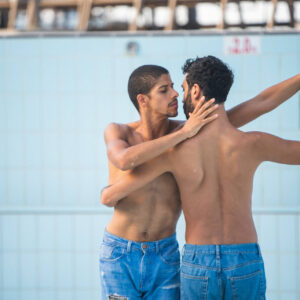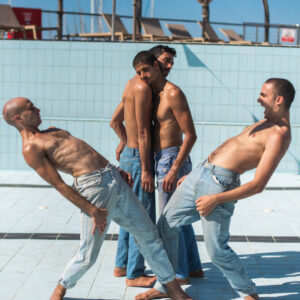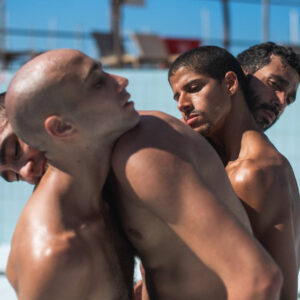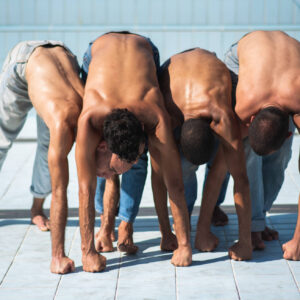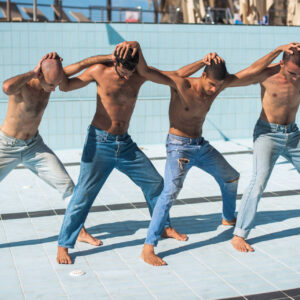Images of modern masculinity in the performance "MARS" by Lior Tavori
There is no guidebook on this planet
There are rules I had to learn
All alone
I made the adjustments
I measured the distances
Today I am erasing the boundaries
(Lior Tavori)
I met Lior Tavori in the pre-pandemic reality - in December 2019, during my visit in Tel Aviv being invited for the 25th anniversary of the International Exposure organized at the Suzanne Dellal Centre for Dance and Theatre. This is an artistic event aimed at presenting and promoting the most interesting Israeli dance productions. The choreographer presented then the performance "HARAMOT" as part of the formula "Courtain up" dedicated to independent and young artists of the Israeli dance scene.
His idea drew my attention, because it stood out from other forms of artistic work by camp aesthetics, dynamic dramaturgy, deliberate re-drawing of the characters and irony. The choreographer, perhaps as the only one of the dozens of artists, used joke as a formal part of the stage play, while creating a socially engaged message. I discussed his performance with him at that time and thus managed to find common grounds of interest for further contact, resulting in this review of his work entitled "MARS".
Due to the development of the pandemic situation in the world, the premiere of Lior Tavori's new play took place online on 28th December 2020 as part of the aforementioned "Courtain Up" Festival.
The performance "MARS" is a intimate choreography created for four dancers. The choreographer managed to create an close-up image of masculinity, which is the theme of his work. The title "MARS" takes us to a planet stereotypically associated with the world of men. "Men are from Mars, women from Venus" is not only the title of a popular guide for those who want to improve their male-female relationships, but it is also a cultural code that is being imprinted into our lives as part of our upbringing, which legitimizes gender stereotypes, showing us what is socially recognized and acceptable as male and female. In the new work the choreographer decided to confront these debatable contexts. Although the concept of gender has been discussed and written about very often recently, I get the impression that this debate often highlights the problem of the coming or ongoing crisis of the male world, which I believe is an unconfirmed generalisation. As a reviewer connected with the world of social science, I believe that the situation is much more complicated but that's not what I would like to write about.
In Tavori' s play, I can find references to masculinity perceived not only in the context of playing social roles. In this precise and coherent choreography there are many threads depicting men and masculinity by looking at them from different angles, which I will try to present below in reference to the dramaturgical line of the performance.
The show began with a sequence in which we see four young dancers dressed neutrally, wearing T-shirts and shorts who used their bodies to create structures that they could jump on or support at. Their physicality was shown as the basis for creating a platform for cooperation and mutual support. We cannot see competition here, but rather male friendship. The first scene was created as a dynamic opening contrasting with nostalgic but disturbing music by Icelandic composer Hildur Guðnadóttir.I want to underline that, in my opinion background music was perfectly connected to the stage space and filled it perfectly, highlighting the nature of the movement activities.
In the next scene, the dancers moved around in a circle watching each other and building tension using minimalistic means of expression. They used only a few still very intense gestures which proved the golden principle that less means more. Their mimics and glances drew our attention. It was as if they were just starting to notice each other and then their bodies by touching them. The touch was very important here, it also concerned intimate body parts, which was not seen as controversial, but rather helped to add realism to the created characters. This can be interpreted as an attempt to build a male identity basing it on our physicality – these gender characteristics that define whether we are considered male or not. It is impossible not to mention here the context of transgender people whose gender identity is different from their physical identity.
The contexts described above were deconstructed by the transition of dancers into the scene of synchronous movement sequences. Brilliant choreography and excellent dancers’ performance leave no doubt that "MARS" is the artistic production, which is excellent both in terms of its semantics as well its choreography and dance. It was impossible to take your eyes off the charismatic dancers, whose movements showed connections with the best traditions of Israeli contemporary dance.
Particular attention should also be given to a clear articulation of movement, dynamics, animalism and the multi-plan use of space with a very simple stage design which consisted only of fluorescent lights placed on the floor, setting the boundaries of the stage.
The next part was created by showing two duos in contrasting movements at separate stage perspectives. In the first scene, the dancers remained in contact with each other, showing off dynamic sequences - movements of physical force suggesting aggression, while the second duo remained close to each other in a tight, calm gesture like a couple associated with the aesthetics of a formal ballroom dance from which all dancers drew their gestures. This scene may have suggested embedding characters in cultural canons, from which it is difficult to get free.
It was a very clever dramaturgical action to use a work of the French poet Anne-James Chaton, whose, lyrics being recited without use of any music, gave the scene the character of repetition, corresponding with the repetitive movement. It might mean that men are being forced into some cultural structures without their consent and by ignoring their true needs. A very moving gesture was the the act of pulling down the trousers and the hand covering the face by three dancers, while one of them performed solo by repeating the characteristic gesture of touching his intimate zones, suggesting that topic of sexuality is extremely important in male reality.
Another solo presented in "MARS" touched the issue of image, the daily role that men show outside to other people. Artificial smile, physical exercises, re-drawn gestures appeared suggesting full control of the situation and showing off stereotypical masculinity in front of the others. A surprising twist turned out to be the final scene danced to the live version of the song "I Want To Break Free" by Queen. The dancers symbolically freed themselves from the restrictive frames of stereotypes, and although they danced the same choreography together, their individuality and authenticity was clearly noticeable as well as their joy of freedom, which in my opinion represents the leading message of this performance.
In conclusion, I will quote psychotherapist and sexologist Michal Pozdał, who aptly states that "the feeling of being a man, experiencing one's gender identity defines men as men. Unfortunately, too often they allow others to decide about their identity by looking at shape of trousers, sexual performance or their musclature. There is no doubt that idea of masculinity is transforming. The old way of defining it is slowly ceasing to be applied, while the new one is still to be formed. Modern women themselves, without the help of fairy-tale knights, freed themselves from prison in a high tower. Similarly, men begin to understand that they do not have to act as dragon slayers to be valued and noticed. And that doesn't mean they've become ‘softies’, because we finally live in a world where men have a choice as to what they want to be and how to live their lives. The crisis sounds too sinister in this situation. We can be more positive and call it the ‘blossoming’ of masculinity."[1]
Although "MARS" focuses maily at the topic of masculinity, in my opinion it is a universal performance, talking about the need of authenticity and about living in harmony with one another.
I am cheering for and supporting Lior Tavori's work and I am convinced that we will hear about him again and his works will be presented on world stages.
[1] M. Pozdał, The blossoming of true masculinity, Newsweek Psychology, 2/16.
Marek Zadłużny
Center for Choreographic Practice
Zielona Góra, Poland
28 March 2021
MARS
Choreography: Lior Tavori
Costumes: Harel Lissman
Dancers/contributors: Ori Moshe Ofri, Amit Marsino, Reches Itzhaki, Tamar Levi
Sound: Reut Yehudai
Music: Queen, Clara Rockmore, Andy Moor, Anne-James Chaton, Carsten Nicolai, Patrick Watson, Hildur Guðnadóttir
Rehearsal Director: Einat Betsalel
Photos: Yair Meyuhas
Video: Cinema kitchen
Lights: Ofer Laufer
